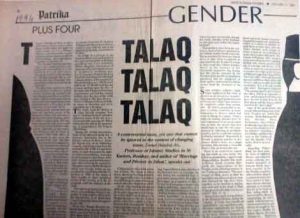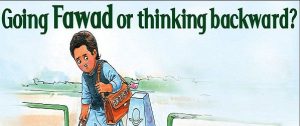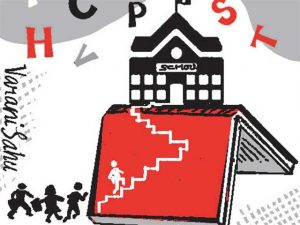
26-10-2016 (Important News Clippings)
To Download Click Here
Push For Equality
Modi slams triple talaq but majority appeasement too is a problem
 Marking a first in the political history of India, Prime Minister Narendra Modi publicly opposed the practice of triple talaq in the Muslim community. Addressing a ‘maha parivartan’ rally in Bundelkhand, Modi asserted that government had a responsibility to protect the constitutional rights of Muslim women from practices that degrade their status in society. This comes after government’s recent opposition to triple talaq and polygamy among Muslims in the Supreme Court. It’s welcome that government has based its position on constitutional principles such as gender equality and secularism. Religious practices, no matter how intrinsically linked to tradition, can’t override the Constitution.
Marking a first in the political history of India, Prime Minister Narendra Modi publicly opposed the practice of triple talaq in the Muslim community. Addressing a ‘maha parivartan’ rally in Bundelkhand, Modi asserted that government had a responsibility to protect the constitutional rights of Muslim women from practices that degrade their status in society. This comes after government’s recent opposition to triple talaq and polygamy among Muslims in the Supreme Court. It’s welcome that government has based its position on constitutional principles such as gender equality and secularism. Religious practices, no matter how intrinsically linked to tradition, can’t override the Constitution.
Plus, for far too long the Muslim community in India has been dominated by diktat from the clergy. And this happened because the country’s political leadership progressively ceded space to Muslim orthodoxy in the hope of reaping political dividends. This in turn has marginalised modern Muslim voices and relegated Muslim women to second-class status. Consider also that several Muslim-majority countries prohibit practices such as triple talaq and polygamy – Pakistan and Bangladesh don’t allow triple talaq while polygamy is prohibited in countries like Turkey and Turkmenistan.That said, the Modi government can’t be selective in its approach. While Modi himself did try to balance his criticism of triple talaq by also condemning female foeticide prevalent among Hindus, this isn’t an exact comparison – though a major social problem, female foeticide isn’t a religious issue. If the aim is to strive for a Uniform Civil Code (UCC) BJP must also revise its majoritarian positions on a gamut of issues, such as the beef ban being championed by several of its state governments, or building a Ram temple on the site of the demolished Babri Masjid. Similarly, not cracking down hard on self-proclaimed gau rakshaks who go around dispensing their brand of vigilante justice, targeting mostly Muslims and Dalits, goes against the very spirit of a uniform code of governance if not a UCC.
For a common civil code needs to be based on secular considerations, not defer to the religious sentiments of one community while reading out constitutional principles to another. Majority appeasement is as much of a problem as minority appeasement. In practice, this will make resistance to a UCC difficult to overcome and even BJP will lack the appetite for it.
Date: 26-10-16
Fawad Khan And Angry Birds
When terrorists attack India, why does the mob turn its ire on Bollywood?

Growing up in what was then Calcutta we were taught what a logical fallacy was through the following thought experiment: Major premise – Rabindranath Tagore has a beard; Minor premise – A goat has a beard; Inference – Rabindranath Tagore is a goat. In an updated version, we might have the following sequence replace it. Major premise – The terrorists in Uri were Pakistani; Minor premise – Fawad Khan is Pakistani; Inference – Fawad Khan is a terrorist. The illogic of such an inference is only matched by its hilarity.
The second, more nuanced version, is that arts and sports are not as important as our soldiers and our national interest. There is a certain intuitive appeal to this argument – art and sport are recreational; it appears to be bad form for the country to be frolicking when its soldiers are dying.
Two grave fallacies affect this argument – first, as far as sport is concerned, it is hypocritical. In the 1999 World Cup as Anil Kumble was cleaning up the Pakistani tail, Indian soldiers were dying in the Kargil war. So perhaps this otherwise intuitive statement should be supplied a caveat – arts and sports are not as important as our soldiers except if we have a chance to beat Pakistan and win the Cricket World Cup.
Second, as far as barring Pakistani actors is concerned, it makes the false claim that responsibility for the actions of a country must be personally borne by each and every one of its citizens. If such a claim were to be made, then every Indian today would have to bear responsibility for state action in deaths due to custodial violence, the failed IPKF mission to Sri Lanka, the deplorable treatment meted out by state institutions to Paralympic athletes or for Pahlaj Nihalani’s comments as chief of the Censor Board. Vicarious responsibility is both a flawed as well as a dangerous argument to make – we should be careful what we wish for.
In this entire episode, the Centre itself has shown no inclination of banning Pakistani artistes or preventing bilateral person-to-person contacts. In fact, foreign secretary S Jaishankar has expressly ruled out such a possibility. Without government incitement a third, more troubling rationale for the genesis of the disengagement with Pakistan theory emerges – that civil society now is essentially one large mob running on unthinking autopilot.Speaking in the name of the army provides a convenient cover, and alleging an affront to Indian dignity caused by a Pakistani actor on screen is a trump card that brooks no further dissent. This holds up a mirror to a new India – small-minded, insecure, illiberal and skittish. No reasoned argument appears possible in such an atmosphere.
Watching Karan Johar respond to the unthinking and mob-like backlash by pleading with the film fraternity and the public to allow his film to release despite Pakistani national Fawad Khan being a member of the cast was sad at many levels. A filmmaker was constrained to prove his Indianness because he had used a Pakistani actor for a film; he was forced to beg that his film be released because it was the product of the blood and sweat, not of 300 workers, but 300 Indian workers; but above all, it was sad because an artist proclaimed that his country and its armed forces came first and so he would not engage with artistes from “a neighbouring country given the circumstance”, a compromise he ultimately accepted.It is a testament to the India we are currently building that an artist chooses nationalism over commitment to his art. And worse still, that he sees the two as distinct.
Government is quite right to target learning outcomes

But much of the blame lies outside the . Restoring Class 10 board examinations, reintroducing detention in elementary classes and doing away with the system of continuous evaluation will not fix the problem. The bulk of the country’s schoolgoing population comprises first-generation learners and those whose parents speak only their mother tongue or dialect. For this reason, teachers play an outsized role in the education of a child. The best way to improve learning is to ensure that teachers are enabled and empowered to go beyond the confines of the textbook in their classrooms.Teachers need to be able to design the learning experience to suit the needs of the classroom such as using the language spoken by the students at home to teach, encouraging peer learning. A crucial intervention is in the early years, both as improved nutritional intake and learning initiatives that will help improve cognitive skills central to improving learning outcomes. Changing demands of the economy, increased globalisation, disruptive practices and technologies make it imperative for the government to ensure that school education system empowers children so that they are not left behind.
The Kigali Breakthrough
Indian intervention ensured a balance between climate concerns and economic needs.

The Indian economy’s expected growth rate and consequently, refrigerant consumption, means that the three major HFC-consuming sectors will have to transition within eight to 10 years of the freeze.
The Kigali Amendment to the Montreal Protocol, agreed to by 197 countries , is a milestone agreement. It will avoid global warming by up to 0.5°C by phasing out hydrofluorocarbons (HFCs), a category of greenhouse gases with extremely high global warming potential (GWP). The amendment is the product of seven years of negotiations. Four amendment proposals were submitted — the North American, European, and small island states’ proposals for developing countries advocated an early baseline (2011-13) and freeze (2021), while the Indian amendment proposed a later baseline (2028-30) and freeze (2031). The narrative of “ambition” was highlighted to convince developing countries to agree to an early phase-down as the majority of future HFC emissions will come from these countries.
The Kigali Amendment settled on two baselines and freeze dates for developing countries: The first group (China, African, Latin American and Asian countries) have an early baseline (2020-22) and freeze (2024) while the second group (India, Pakistan, Iran, Iraq and Gulf countries) have a later baseline (2024-26) and freeze (2028). The amendment has been described as an equitable agreement for India and other developing countries. It allows them to choose between the two baselines, in light of their circumstances.
Indian negotiators had two objectives — securing an ambitious global HFC phase-down and ensuring that the Indian market does not pay disproportionately for it. The Indian government drew on India-specific research and stakeholder interactions to arrive at a better understanding of the implications of the different amendment proposals for the country. Apart from China, India is the only other developing country to have HFC producing capacity. India also has large and growing air-conditioning, refrigeration and automobile manufacturing sectors, which would face technical and financial challenges due to the HFC phase-down.
The issue of economy-wide costs was highlighted by the Indian negotiators during a multilateral meeting in Vienna in July 2016. This intervention widened the narrative, to include the trade-off between economic burden and climate benefits. Despite this, at the beginning of the negotiations in Kigali, countries were still at loggerheads over baselines since a later baseline for developing countries would not achieve a significant reduction in HFC emissions. Indian negotiators emphasised that if China would take deeper cuts than other developing countries, an ambitious amendment was possible. China and India’s business as usual HFC emissions in 2050 would be 31 per cent and seven per cent, respectively, of global HFC emissions. A Council on Energy, Environment and Water’s analysis, in June 2015, showed that if China is taken out of the equation, the Indian proposal could mitigate a bulk of emissions from other developing countries. China’s HFC emissions were expected to grow hugely between 2015 and 2030 — and thereafter peak and decline — while India and other developing countries’ emissions would be significant only after 2030. Thus, a differentiation between different groups of developing countries was introduced.The Indian economy’s high expected growth rate and consequently, refrigerant consumption, means that the three major HFC-consuming sectors (mobile, residential and commercial air-conditioning) will have to transition within eight to 10 years of the freeze. If 2021 had been the freeze year, a transition to low GWP alternatives by 2031 may have been difficult given the current lack of availability of patent-free and low-cost options in many sectors.
The HFC negotiation changed from a focus on ambition to one cognisant of countries’ climate mitigation goals, economy-wide costs, differentiation, and high growth rates. Recognising the role of China’s disproportionately large emissions, Chinese negotiators agreed that China will need to act after the developed world, but before India. Developing countries which are dependent on Chinese imports have chosen the earlier baseline. The Kigali amendment is the first agreement that clearly distinguishes China’s climate impact from India, with which it is generally clubbed, hence it is path breaking.
While Indian negotiators have been successful in reaching an agreement the country can work with many challenges remain. Financial assistance to developing countries was not fully decided at Kigali. With the upcoming phasedown of HFCs, the government and industries will have to scale up support for indigenous research to ensure that the technically sound and cost-effective options are available for all sectors.
Vaibhav Chaturvedi , Lekha Sridhar
उम्र की सीमा
सरकार की दीर्घकालिक नीति क्या है, यह हमें नहीं पता, अभी सिर्फ एक भ्रम दूर हुआ है। कार्मिक मंत्रालय ने यह स्पष्ट कर दिया है कि सरकार अगले साल होने वाली सिविल सेवा परीक्षा के लिए अधिकतम उम्र-सीमा को फिलहाल नहीं घटा रही है। यानी इस परीक्षा के लिए सारी अहर्ताएं इस बार भी वही होंगी, जो अभी तक होती आई हैं। पिछले काफी समय से यह चर्चा थी कि सरकार सिविल सेवा परीक्षा के लिए अधिकतम उम्र-सीमा को घटा सकती है। इस चर्चा की वजह थी, बीएस बासवान समिति की रिपोर्ट। यह समिति सिविल सेवा परीक्षा में सुधार के लिए बनाई गई थी।समिति की सिफारिश थी कि इस परीक्षा की अहर्ताओं में अधिकतम उम्र-सीमा को 32 से घटाकर 26 वर्ष कर दिया जाए। फिलहाल सरकार ने इस सिफारिश को नहीं माना है और यह कहा जा रहा है कि ऐसा अगले साल की शुरुआत में कई राज्यों के विधानसभा चुनावों को ध्यान में रखकर किया जा रहा है। सरकार नहीं चाहती कि ऐसे मौके पर युवा-वर्ग को नाराज किया जाए। इस मामले में कार्मिक मंत्रालय के सचिव ने जो बयान दिया है, वह सिर्फ 2017 की प्रवेश परीक्षा के संदर्भ में है। इसलिए हमें नहीं पता कि सरकार बासवान समिति की सिफारिशों से सहमत है या नहीं, और उन्हें वह स्वीकार करने जा रही है या नहीं।आगामी चुनावों को छोड़ दें, तो भी उम्र की सीमा कम करने का मुद्दा काफी संवदेनशील है। इसे एकबारगी किए जाने के कई खतरे हैं। भारतीय सिविल सेवा परीक्षा देश की सबसे कठिन परीक्षाओं में गिनी जाती है। अगर हम पिछले साल का उदाहरण लें, तो पिछले साल इस परीक्षा में दस लाख से ज्यादा नौजवान शामिल हुए थे, जिनमें अंत में सिर्फ 180 का ही चुनाव हुआ। यह बताता है कि इसमें स्पद्र्धा कितनी ज्यादा है। इसी कड़ी स्पर्धा की वजह से ही बहुत से युवा परीक्षा में बैठने से पहले कई साल तक तैयारी करते हैं।
अभी इस परीक्षा में बैठने की न्यूनतम उम्र-सीमा 21 साल है और अधिकतम उम्र-सीमा 32 साल। और इस 11 साल में सामान्य वर्ग का कोई युवा सिर्फ छह बार ही यह परीक्षा दे सकता है। इसलिए भी बहुत से नौजवान कई साल तक तैयारी करने के बाद परीक्षा में बैठना पसंद करते हैं। ऐसे में, अगर एकबारगी उम्र-सीमा घटा दी जाती है, तो उन नौजवानों को काफी परेशानी हो सकती है, जो परीक्षा के लिए लगातार कई साल से तैयारी कर रहे हैं।बासवान समिति की पूरी रिपोर्ट अभी तक सार्वजनिक नहीं की गई है, इसलिए हम ठीक से नहीं जानते कि अधिकतम उम्र घटाने की सिफारिश के पीछे क्या तर्क दिए गए हैं। इसे लेकर हमेशा से जो कुछ तर्क दिए जाते रहे हैं, फिलहाल हम उन्हीं पर चर्चा कर सकते हैं। सिविल सेवा परीक्षा पास करने वाले उम्मीदवार को दो साल तक मसूरी के संस्थान में प्रशिक्षण दिया जाता है, जिसके बाद उसकी नियुक्ति भारतीय प्रशासनिक सेवा, यानी आईएएस में होती है।
मान लीजिए कि 32 साल का एक युवक सिविल सेवा परीक्षा को पास करता है, तो जब वह प्रशासनिक सेवा में तैनात होगा, तो उसकी उम्र 34 साल हो चुकी होगी। आमतौर पर यह माना जाता है कि किसी व्यक्ति की काम करने की ऊर्जा और उत्पादकता 30 साल की उम्र के आस-पास शिखर पर होती है और उसके बाद धीरे-धीरे कम होने लगती है। इस तर्क से देखें, तो बहुत से लोग आईएएस तब बनते हैं, जब काम करने की उनकी ऊर्जा कम होनी शुरू हो चुकी होती है। बेशक इसमें बदलाव जरूरी है, पर यह ऐसा काम नहीं है, जिसे एकबारगी किया जा सके। अधिकतम उम्र-सीमा नीचे लाने की एक प्रक्रिया बनानी होगी। यह काम धीरे-धीरे होगा, जिसमें कई साल लग सकते हैं।
